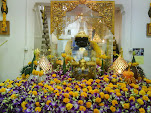 This large and extensive temple neighbours the Grand Palace on Thai Wang Road and houses the very impressive gigantic gold plated reclining Buddha which is some 46 metres long and 15 metres high. Its soles are inlaid with mother of pearl. The temple is regarded as the first centre of public education and is sometimes call Thailand's first university.
This large and extensive temple neighbours the Grand Palace on Thai Wang Road and houses the very impressive gigantic gold plated reclining Buddha which is some 46 metres long and 15 metres high. Its soles are inlaid with mother of pearl. The temple is regarded as the first centre of public education and is sometimes call Thailand's first university.A view from one of the largest Chedis where there is an entrance. Chedi usually contain a relic of the Buddha or the ashes of a king or an important monk. The function is similiar to the pyramids in Egypt. The large Wiharn (building that houses Buddha images) in this image houses the Reclining Buddha.
The other name for Wat Pho is Wat Phra Chetuphon. The Reclining Buddha and the mother of pearl. Other than the Buddha statue the walls surrounding it are covered with beautiful Thai paintings. The head side of the Reclining Buddha. The Wiharn which houses the Reclining Buddha is a large building from the outside but when inside feels small.
The Chedis are decorated chinese ceramic tiles. Very carefully detailed. There are 95 Chedis in Wat Po.
Address:2 Sanamchai Road Phra Borommaharatchawang Sub-District Phra Nakhon District Bangkok 10200
Opening Hours:
Temple: Daily 8 am-5 pm
Ubosot: Daily 8 am-5 pm
Admission Fee:Foreigner 50 Baht












